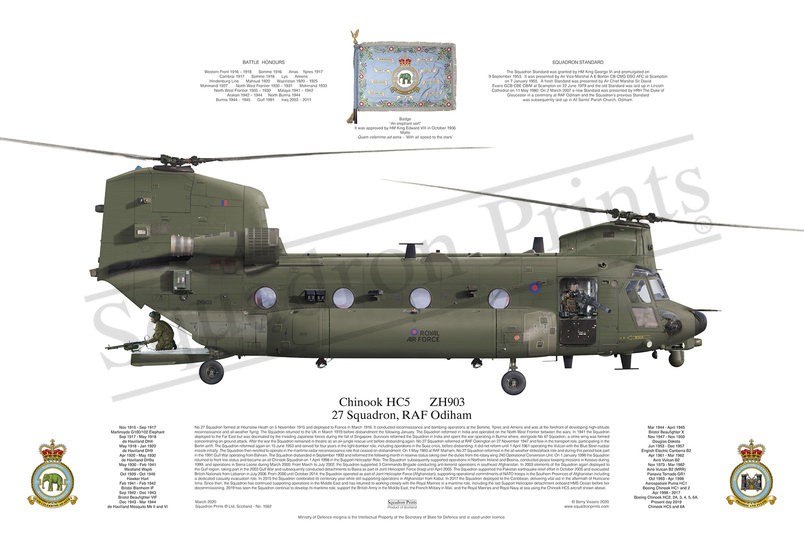#1562 Chinook HC5

Description
Squadron Prints Lithograph No. 1562 - ZH903, Chinook HC5, 27 Squadron, RAF Odiham.
No 27 Squadron formed at Hounslow Heath on 5 November 1915 and deployed to France in March 1916. It conducted reconnaissance and bombing operations at the Somme, Ypres and Amiens and was at the forefront of developing high-altitude reconnaissance and all-weather flying. The Squadron returned to the UK in March 1919 before disbandment the following January. The Squadron reformed in India and operated on the North West Frontier between the wars. In 1941 the Squadron deployed to the Far East but was decimated by the invading Japanese forces during the fall of Singapore. Survivors reformed the Squadron in India and spent the war operating in Burma where, alongside No 47 Squadron, a strike wing was formed concentrating on ground attack. After the war the Squadron remained in theatre as an air-jungle rescue unit before disbanding again. No 27 Squadron reformed at RAF Oakington on 27 November 1947 and flew in the transport role, participating in the Berlin airlift. The Squadron reformed again on 15 June 1953 and served for four years in the light-bomber role, including operations in the Suez crisis, before disbanding. It did not reform until 1 April 1961 operating the Vulcan with the Blue Steel nuclear missile initially. The Squadron then rerolled to operate in the maritime radar reconnaissance role that ceased on disbandment. On 1 May 1983 at RAF Marham, No 27 Squadron reformed in the all-weather strike/attack role and during this period took part in the 1991 Gulf War operating from Bahrain. The Squadron disbanded in September 1993 and reformed the following month in reserve status taking over the duties from the rotary wing 240 Operational Conversion Unit. On 1 January 1998 the Squadron returned to front line status and became an all Chinook Squadron on 1 April 1998 in the Support Helicopter Role. The Squadron subsequently supported operations in Northern Ireland and Bosnia, conducted peace keeping missions in Kosovo during 1999, and operations in Sierra Leone during March 2000. From March to July 2002, the Squadron supported 3 Commando Brigade conducting anti-terrorist operations in southeast Afghanistan. In 2003 elements of the Squadron again deployed to the Gulf region, taking part in the 2003 Gulf War and subsequently conducted detachments to Basra as part of Joint Helicopter Force (Iraq) until April 2005. The Squadron supported the Pakistan earthquake relief effort in October 2005 and evacuated British Nationals from Lebanon in July 2006. From 2006 until October 2014, the Squadron operated as part of Joint Helicopter Force (Afghanistan), supporting operational commitments of NATO troops in the Southern Provinces of Afghanistan including a dedicated casualty evacuation role. In 2015 the Squadron celebrated its centenary year while still supporting operations in Afghanistan from Kabul. In 2017 the Squadron deployed to the Caribbean, delivering vital aid in the aftermath of Hurricane Irma. Since then, the Squadron has continued supporting operations in the Middle East and has returned to working closely with the Royal Marines in a maritime role, including the last Support Helicopter detachment onboard HMS Ocean before her decommissioning. 2019 has seen the Squadron continue to develop its maritime role, support the British Army in the Middle East, the French Military in Mali, and the Royal Marines and Royal Navy at sea using the Chinook HC5 aircraft shown above.
You may also like
-
various
variousLondon Air Traffic Control CentreRAF Brize Norton; RAF Cranwell; RAF Lakenheath; RAF Linton-on-Ouse; RAF Lyneham; RAF Marham; RAF Mildenhall; RAF Valley; RAF Wittering; RAF Coningsby
